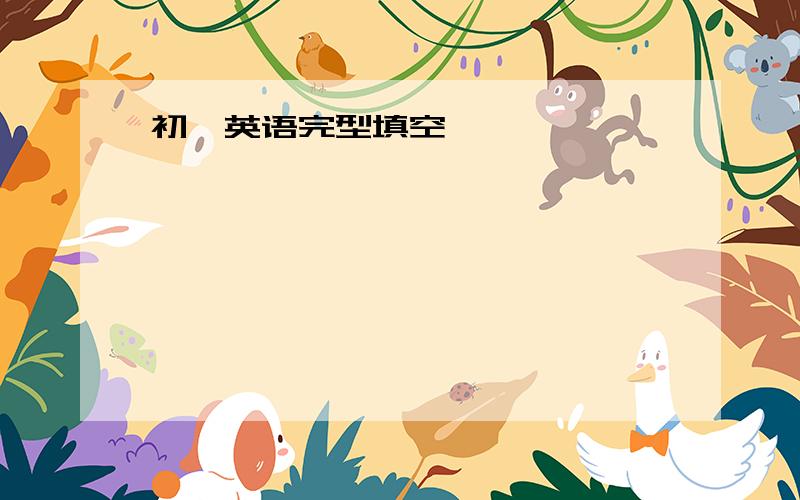初一英语完型填空
来源:学生作业帮助网 编辑:作业帮 时间:2024/04/28 05:39:13

初一英语完型填空
初一英语完型填空
初一英语完型填空
等什么啊?你等还是让我们等啊?
好,你慢慢等!
Once there was a boy in Toronto. His name was Jimmy . He started drawing when he was three years old ,and when he was five he was already very (1) at it . He drew many beautiful interesting oictures ,...
全部展开
Once there was a boy in Toronto. His name was Jimmy . He started drawing when he was three years old ,and when he was five he was already very (1) at it . He drew many beautiful interesting oictures , and many people (2) his pictures , and many people (2) his pictures . They thought this boy was going to be (3) when he was a little older , and then they were going to
(4) these pictues for a lot of money .
Jimmy’s pictures were quite different from other (5) because he never drew on all of tthe paper .He drew on (6) of it , and the other half was always (7)
“That’s very clever , “everybody said. “(8) other people have ever done that before .”
One day somebody asked him , “Please tell me , Jimmy . Why do you draw on the bottom (底部) half of your pictures ,(9) not on the top half ?”
“Because I’m small , “ Jimmy said , “and my brushes (毛笔) can’t (10) very high. “
1.A.poor B.sad C.glad D.good
2.A.bought B.brought C.sold D.took
3.A.different B.clever C.famous D.rich
4.A.buy B.show C.leave D.sell
5.A.men’s B.people’s C.boy’s D.child’s
6.A.half B.part C.side D.end
7.A.full B.empty C.wrong D.ready
8.A.No B.Some C.Any D. Many
9.A.then B.and C.but D.or
10.A.change B.turn C.pull D.reach 答案:1-5 DACDB
6-10 ABACD
收起
呵呵,还有这样的问题,头一次见到
??
我选了两篇,并附了解析,供你参考:
No. 01
Mr Smith lives in the small village, but he works in an office in a big city. He goes to work by train every morning and comes ___1___ the same way.
One morning wh...
全部展开
我选了两篇,并附了解析,供你参考:
No. 01
Mr Smith lives in the small village, but he works in an office in a big city. He goes to work by train every morning and comes ___1___ the same way.
One morning while he was ___2___ his newspaper on the train, a man ___3___ him came up to him. Mr Smith had not met him before. The man said,“ ___4___ ” to him and then ___5___ to talk to him. The man said, “Your ___6___ isn’t interesting, is it? You got on the same train at the same station at the same time ___7___ morning and you always sit in the same seat and read the same newspaper.”
When Mr Smith ___8___ this, he put his newspaper down, turned around and ___9___ to the man angrily, “How do you know all that about me?”
“Because I’m ___10___ sitting in the same seat behind you,” the man answered.
1. A. family B. house C. village D. home
2. A. seeing B. look C. reading D. finding
3. A. before B. behind C. beside D. next to
4. A. Sorry B. Thanks C. Hello D. Goodbye
5. A. refused B. stopped C. ordered D. began
6. A. life B. work C. office D. child
7. A. one B. every C. this D. yesterday
8. A. heard B. listened C. found D. felt
9. A. asked B. said C. told D. talked
10. A. never B. hardly C. always D. sometimes
本文是个幽默故事。讲述一个人说另一个人每天早上重复做同一件事,这样生活单调,其实自己也一样。
1. D 表示回家是come home与前面的去上班go to work相对。
2. C 表示看书看报用read。
3. B 由文末I’m sitting in the same seat behind you可知。
4. C 从下文可知是向他召呼问好,所以是say “Hello” to him。
5. D 打了召呼后自然就会开始(began) 谈起话来。
6. A 在同一时间、同一个车站、乘同一个火车,这是种单是调泛味的生活 (life)。而不是这工作,也不是办公,更不是指小孩。
7. B 指每天早上都是如此,才会说单调泛味。
8. A 史密斯先生听到(heard) 这些话。listen指有意识在“听”,强调动作,后接宾语时要加to;hear指听的结果“听到”。
9. B say to sb对某人说。虽然后面是一个问句,但表示问某人时ask后不用to,而直接说ask sb。
10. C 因为对史密斯先生如此了解,当然是“总”总在他的后面了。
No. 02
Once there was a boy in Toronto. His name was Jimmy. He started drawing when he was three years old, and when he was five he was already very ___1___ at it. He drew many beautiful interesting pictures, and many people ___2___ his pictures. They thought this boy was going to be ___3___ when he was a little older, and then they were going to ___4___ these pictures for a lot of money.
Jimmy’s pictures were quite different from other ___5___ because he never drew on all of the paper. He drew on ___6___ of it, and the other half was always ___7___.
“That’s very clever,” everybody said. “___8___ other people have ever done that before.”
One day somebody asked him, “Please tell me, Jimmy. Why do you draw on the bottom (底部) half of your pictures, ___9___ not on the top half?”
“Because I’m small,” Jimmy said, “and my brushes (毛笔) can’t ___10___ very high.”
本文是具有一定的讽刺意义的故事。讲述一个绘画风格与众不同的孩童,他在纸上总是留出一半不画,别人都以为他特别聪明,最后通过孩童自己的口揭示了其中的密秘。
1. A. poor B. sad C. glad D. good
2. A. bought B. brought C. sold D. took
3. A. different B. clever C. famous D. rich
4. A. buy B. show C. leave D. sell
5. A. men’s B. people’s C. boy’s D. child’s
6. A. half B. part C. side D. end
7. A. full B. empty C. wrong D. ready
8. A. No B. Some C. Any D. Many
9. A. then B. and C. but D. or
10. A. change B. turn C. pull D. reach
1. D 由后文he drew many beautiful interesting pictures可知,他是“擅长(be good at)”绘画。
2. A 这画又漂亮又有趣,当然就很多人“买”了。
3. C 根据常识推理,现在就画得如此之后,他长大后自然就会很“有名(famous)”。
4. D 由后面的for a lot of money可知,是将原来买的画卖掉赚钱。
5. B 是说他的画与别人的画不同,而不是与别人男人的画不同,所以排除A;又因other后应当接复数可数名词,而C和D是单数,所以也错了。
6. A 由后面的the other half可知。
7. B 由前文he never drew on all of the paper和He drew hall of it,可以推知另一半是“空白(empty)”。
8. A 上文已经说了他的画与众不同,他这样画一半留一半,由此,推断没有别的人像这样做。
9. C 前后是转折关系。
10. D因为自己还太矮小,所以伸手达不到那么高。
收起